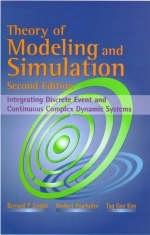
Theory of Modeling and Simulation
Academic Press Inc (Verlag)
978-0-12-778455-7 (ISBN)
- Titel erscheint in neuer Auflage
- Artikel merken
The increased computational power and software tools available to engineers have increased the use and dependence on modeling and computer simulation throughout the design process. These tools have given engineers the capability of designing highly complex systems and computer architectures that were previously unthinkable. Every complex design project, from integrated circuits, to aerospace vehicles, to industrial manufacturing processes requires these new methods. This book fulfills the essential need of system and control engineers at all levels in understanding modeling and simulation. This book, written as a true text/reference has become a standard sr./graduate level course in all EE departments worldwide and all professionals in this area are required to update their skills.The book provides a rigorous mathematical foundation for modeling and computer simulation. It provides a comprehensive framework for modeling and simulation integrating the various simulation approaches. It covers model formulation, simulation model execution, and the model building process with its key activities model abstraction and model simplification, as well as the organization of model libraries. Emphasis of the book is in particular in integrating discrete event and continuous modeling approaches as well as a new approach for discrete event simulation of continuous processes. The book also discusses simulation execution on parallel and distributed machines and concepts for simulation model realization based on the High Level Architecture (HLA) standard of the Department of Defense.
Bernard P. Zeigler, is a Professor of Electrical & Computer Engineering at the University of Arizona and co-director of the Arizona Center for Integrative Modeling and Simulation. He is the author of numerous books and publications, a Fellow of the IEEE, and of the Society for Modeling and Simulation International. Zeigler is currently heading a project for the Joint Interoperability Test Command (JITC) where he is leading the design of the future architecture for large distributed simulation events for the Joint Distributed Engineering Plant (JDEP). He is also developing DEVS-methodology approaches for testing mission thread end-to-end interoperability and combat effectiveness of Defense Department acquisitions and transitions to the Global Information Grid with its Service Oriented Architecture (GIG/SOA). Herbert Praehofer is an Assistant Professor at the Johannes Kepler University in Linz, Austria. He has over 50 publications in international journals and conference proceedings on Modeling and Computer Simulation, Systems Theory, and Software Engineering. Tag Gon Kim is a Professor of Electrical Engineering at the Korea Advanced Institute of Science and Technology (KAIST), Taejon, Korea. His research interests include discrete event systems modeling/simulation, computer/communication systems analysis, and object-oriented simulation engineering. He is a senior member of IEEE and SCS, and a member of ACM.
Part I: Basics.
Introduction to Systems Modeling Concepts.
Framework for Modeling and Simulation.
Modeling Formalisms and Their Simulators.
Introduction to Discrete Event System Specifications (DEVS).
Hierarchy of System Specifications.
Part II: Modeling Formalisms and Simulation Algorithms.
Basic Formalisms: DEVS, DTSS, DESS.
Basic Formalisms: Coupled Multicomponent Systems.
Simulators for Basic Formalisms.
Multiformalism Modeling and Simulation.
DEVS-Based Extended Formalisms.
Parallel and Distributed Discrete Event Simulation.
Part III: System Morphisms: Abstraction, Representation, Approximation.
Hierarchy of System Morphisms.
Abstraction: Constructing Model Families.
Verification, Validation, Approximate Morphisms: Living with Error.
DEVS and DEVS-like Systems: Universality and Uniqueness.
DEVS Representation of Systems.
Part IV: System Design and Modeling and Simulation Environments.
DEVS-Based Design Methodology.
System Entity Structure/Model Base Framework.
Collaboration and the Future.
| Erscheint lt. Verlag | 18.1.2000 |
|---|---|
| Verlagsort | San Diego |
| Sprache | englisch |
| Maße | 178 x 254 mm |
| Gewicht | 1080 g |
| Themenwelt | Informatik ► Grafik / Design ► Digitale Bildverarbeitung |
| Mathematik / Informatik ► Informatik ► Software Entwicklung | |
| Informatik ► Weitere Themen ► Hardware | |
| Technik | |
| ISBN-10 | 0-12-778455-1 / 0127784551 |
| ISBN-13 | 978-0-12-778455-7 / 9780127784557 |
| Zustand | Neuware |
| Haben Sie eine Frage zum Produkt? |
aus dem Bereich



